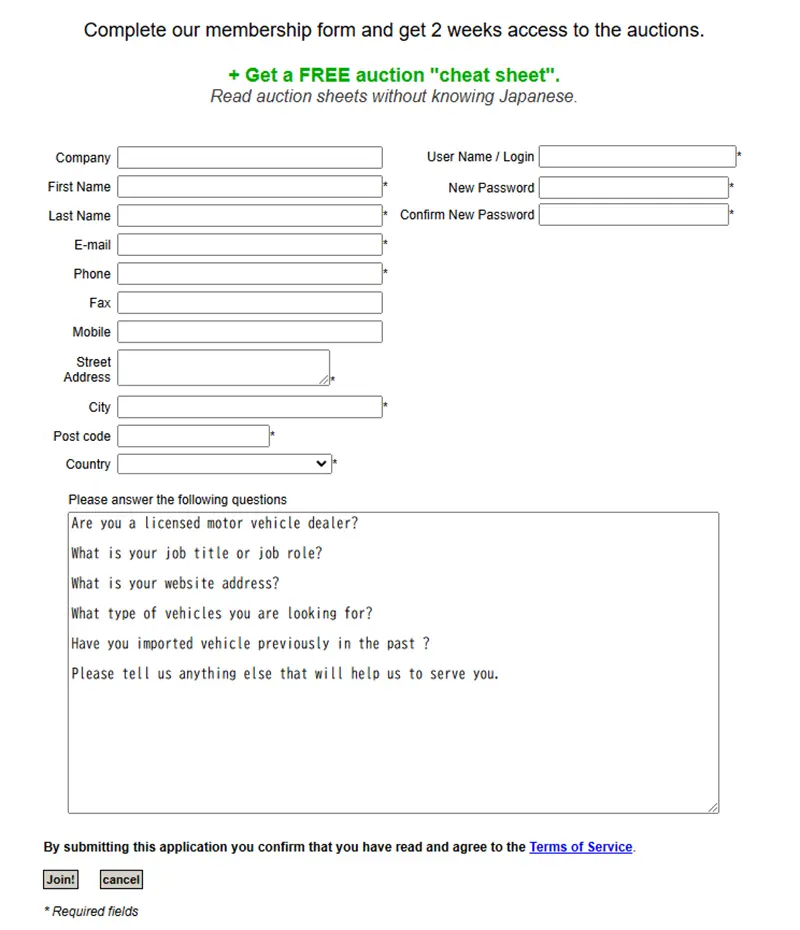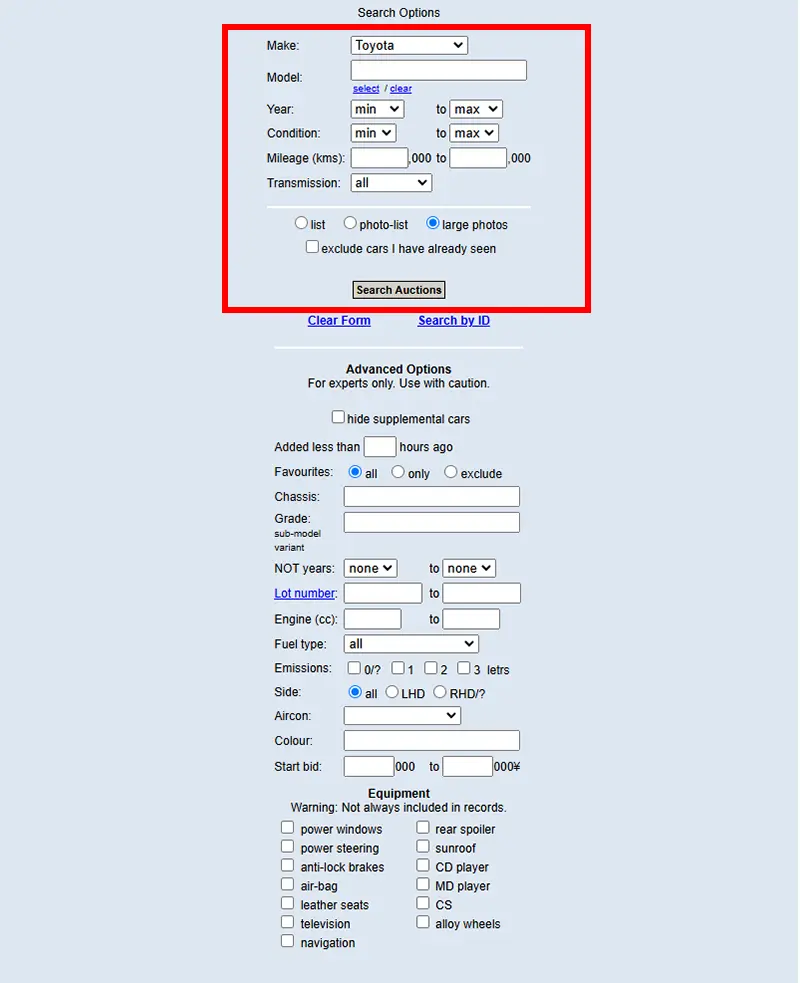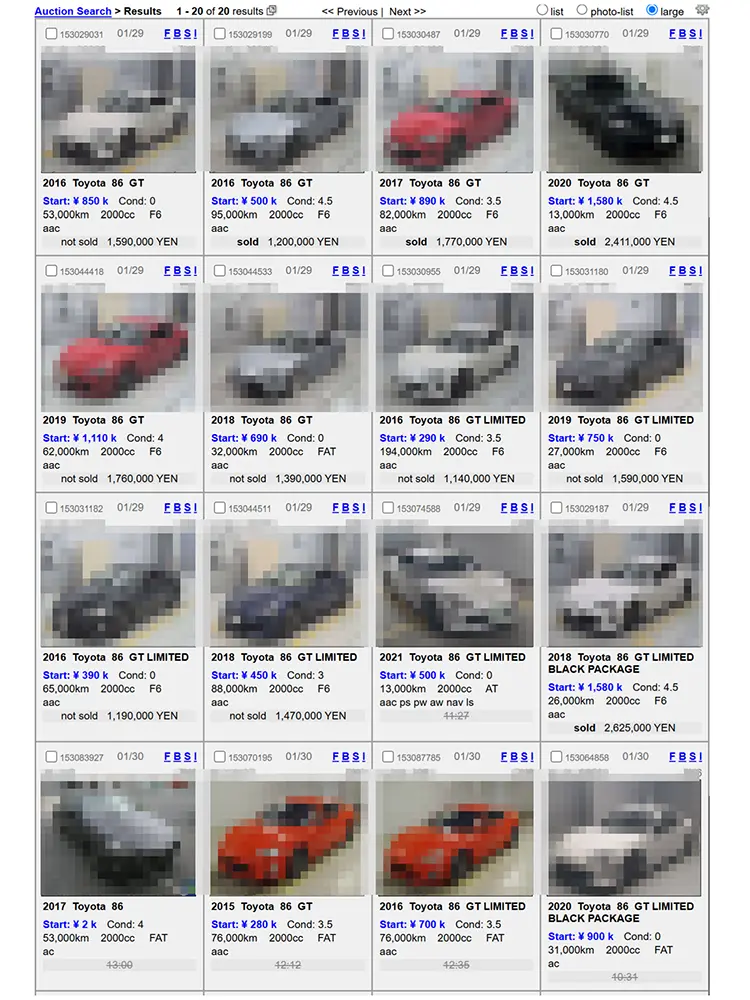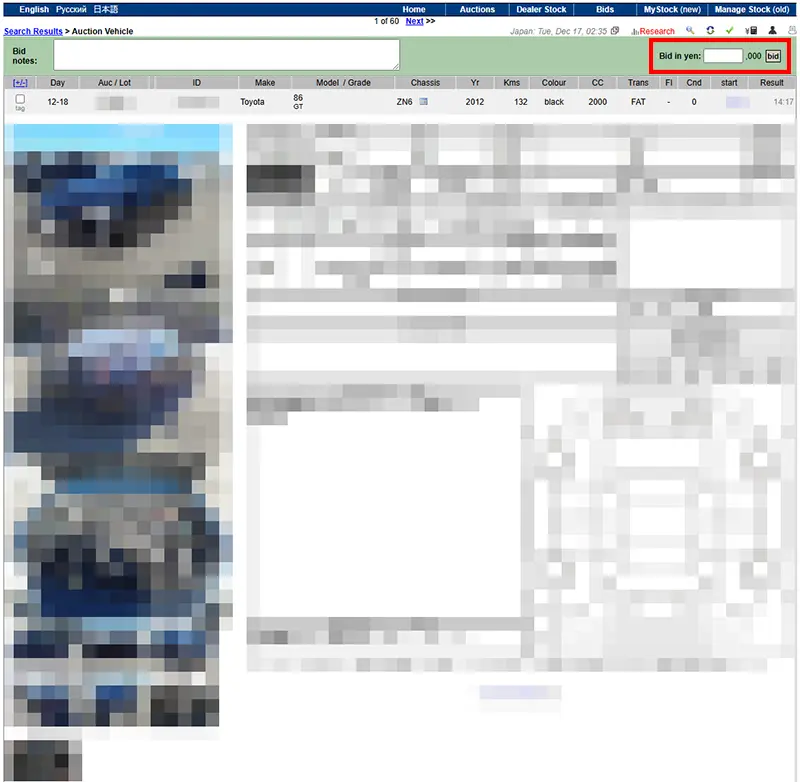There are 123 used-car auction venues in Japan, and the auctions are divided into two types: independent auctions and manufacturer auctions. The largest independent auction is USS Auto Auction, while in the manufacturer auctions, the TAA Auction operated by the Toyota Group is the prominent one.
In independent auctions, anyone can list a vehicle, whereas manufacturer auctions mainly feature trade-in cars from dealers. Although independent auctions offer a wide variety of vehicles because anyone can list, the quality is not consistent. In contrast, manufacturer auctions tend to maintain a certain level of quality.
How to Participate in
Japan Car Auctions
STEP
Membership Registration
First, please complete the free membership registration.

STEP
Vehicle Search & Translation
Additionally, request a translation to accurately understand the information on the auction sheet.


STEP
Consult with an Agent
Ensure that your country's import regulations match the vehicle specifications. Also, check the transportation costs from the auction venue and the final total amount.

STEP
Deposit Payment
Once the conditions are met, please make the required deposit payment and proceed with bidding.
Either a minimum of 100,000 yen, if the car value to be bid on is less than a million yen or 10% of the value of the vehicle you want to purchase.

STEP
Place your bid
Once you have deposited your security deposit, please enter any number of your choice on the bidding page.
Four Flexible Pricing Plans
We offer four pricing plans tailored to different business needs:
- Basic Plan: ¥80K (for those purchasing 10 or more cars per month)
- Dealer Plan: ¥80K + 3% (for those purchasing 3 to 9 cars per month)
- Private Plan: ¥90K + 5%
- Premium Plan: ¥400K + 5%

Reliability of Japanese Car Auctions
One of the biggest concerns when participating in a Japanese auction is whether Japanese used cars are truly reliable.
Needless to say, Japanese used cars are highly valued and trusted worldwide.
While auctions are not 100% foolproof, we can confidently say that they are more reliable than any other used car auctions globally, and of course, more affordable.
However, despite their high reputation, making the decision to purchase is not always easy.
Public Data Supporting the Reliability of Japanese Car Auctions
The Japanese used car market is one of the largest in the world. According to IMARC Group, the market was valued at $666.7 billion in 2024 and is expected to reach $1,231.6 billion by 2033.
This represents a Compound Annual Growth Rate (CAGR) of 6.38% from 2025 to 2033, confirming the steady and continuous growth of the Japanese used car market.
(Source: IMARC Group)

Furthermore, Japanese auctions guarantee traceability of vehicle mileage and accident history. According to a report from the Ministry of Land, Infrastructure, Transport and Tourism (MLIT), services are available to provide consumers with detailed history reports on used cars.
Efforts Required for the Development of Traceability Services (Japanese Site)>https://www.mlit.go.jp/common/001063634.pdf?utm_source=chatgpt.com
Provide Cars’ Reliable Support System
At Provide Cars, each customer is assigned a dedicated agent to support them throughout the vehicle purchase process.
We offer free translation services and conduct thorough re-checks of the vehicles you bid on, ensuring a careful and reliable process.
With this support, we are confident that you can purchase your car with complete peace of mind.
Reliable agent team
Now, Why Not Participate in the Auction?
That’s all for the explanation about auctions. Why not take the next step and actually participate in one? By registering for free on our site, you will have access to auction information from 123 locations across Japan. Once you make a deposit(BANK INFO), you can immediately start bidding on any vehicles that catch your eye.
If you still feel uncertain and want to learn more about Japanese auctions, we recommend accessing Education Provide Cars, as mentioned earlier. Additionally, our site has dedicated pages introducing major auction sites. Please check out information on USS Auctions, TAA Auctions, CAA Auctions, and other auction sites to learn more.
Auction Date
For more detailed auction dates, click here. > Japan Car Auction Days
| Monday | Tuesday | Wednesday | Thursday | Friday | Saturday |
|---|---|---|---|---|---|
| Honda AA Hokkaido | SAA Sapporo AA | USS Sapporo | TAA Hokkaido | JU Sapporo | JU Yamagata |
| Honda AA Sendai | JU Aomori | USS Tohoku | JU Hukushima | JU Hakodate | Arai Auction Van & Truck |
| JU Tokyo | CAA Tohoku | JU Akita | TAA Tohoku | JU Kushiro | USS Gunma |
| Honda AA Tokyo | Arai Auction Sendai Venue | JU Ibaraki | Arai Auction 4-Wheel Oyama | JU Obihiro | ZIP Tokyo |
| Honda AA Nagoya | Arai Auction General Machinery Oyama Venue | MIRIVE Saitama | JU Gunma | JU Muroran | TAA Yokohama |
| Nissan Osaka AA | JU Saitama AA | Hero Members AA | TAA Kantou | JU Asahikawa | USS Hokuriku |
| Honda AA Kansai | CAA Tokyo | IMA Tokyo | USS Tokyo | JU Kitami | JU Yamanashi |
| NAA Hiroshima | USS Yokohama | JAA | JU Kanagawa | JU Miyagi | JU Gifu Hashima AA |
| Honda AA Kyushu | Arai Auction Bayside Venue | USS Nigata | JU Toyama | JU Tochigi | USS Shizuoka |
| Aucnet | JU Hukui | JU Ishikawa | Suzuki AA Hamamatsu | USS Saitama | Arai AA Kansai |
| JU Nagano | CAA Chubu | JU Aichi | JU Chiba | HAA Kobe | |
| CAA Gihu | KCAA Kyoto | NAA Nagoya | Arai Auction Bayside Venue | TAA Hyougo | |
| JU Shizuoka | IAA Osaka | TAA Chubu | NAA Tokyo | JU Nara | |
| Aichi AA | Bay-auc | NAA Osaka | JU Niigata | USS Okayama | |
| USS-R Nagoya | USS Kobe | MIRIVE Osaka | NDAA | USS Shikoku | |
| JU Mie | LAA Shikoku | Arai AA Kansai | USS Nagoya | USS Kyushu | |
| TAA Kinki | USS Hukuoka | ZIP Osaka | MIRIVE Aichi | ||
| Arai AA Kansai | JU Nagasaki | JU Hiroshima | USS Osaka | ||
| JU Tottori | JU Kumamoto | KCAA Hukuoka | Arai AA Kansai | ||
| TAA Hiroshima | JU Oita | IMA Kyushu | IMA Kobe | ||
| JU Yamaguchi | KCAA South Kyushu | JU Miyazaki | JU Shimane | ||
| TAA Shikoku | LAA Okayama | ||||
| TAA Ehime Satellite | HAA Hiroshima AA | ||||
| NAA Hukuoka | KCAA Yamaguchi | ||||
| TAA Kyushu | JU Hukuoka | ||||
| Arai AA Hukuoka | JU Kagoshima | ||||
| TAA South Kyushu | JU Okinawa |

Are you searching for the most reliable, efficient, and hassle-free way to import cars from Japan?
Partner with us and enjoy smooth, stress-free results!
- Absolutely FREE to get started
- Browse at your leisure
- Your information is 100% secure
no fees, no spam, just smooth car imports!




